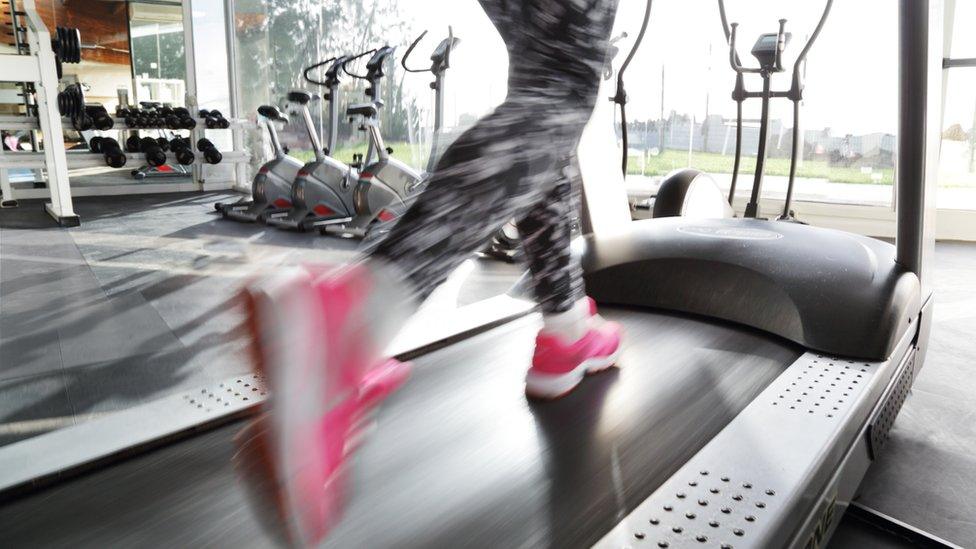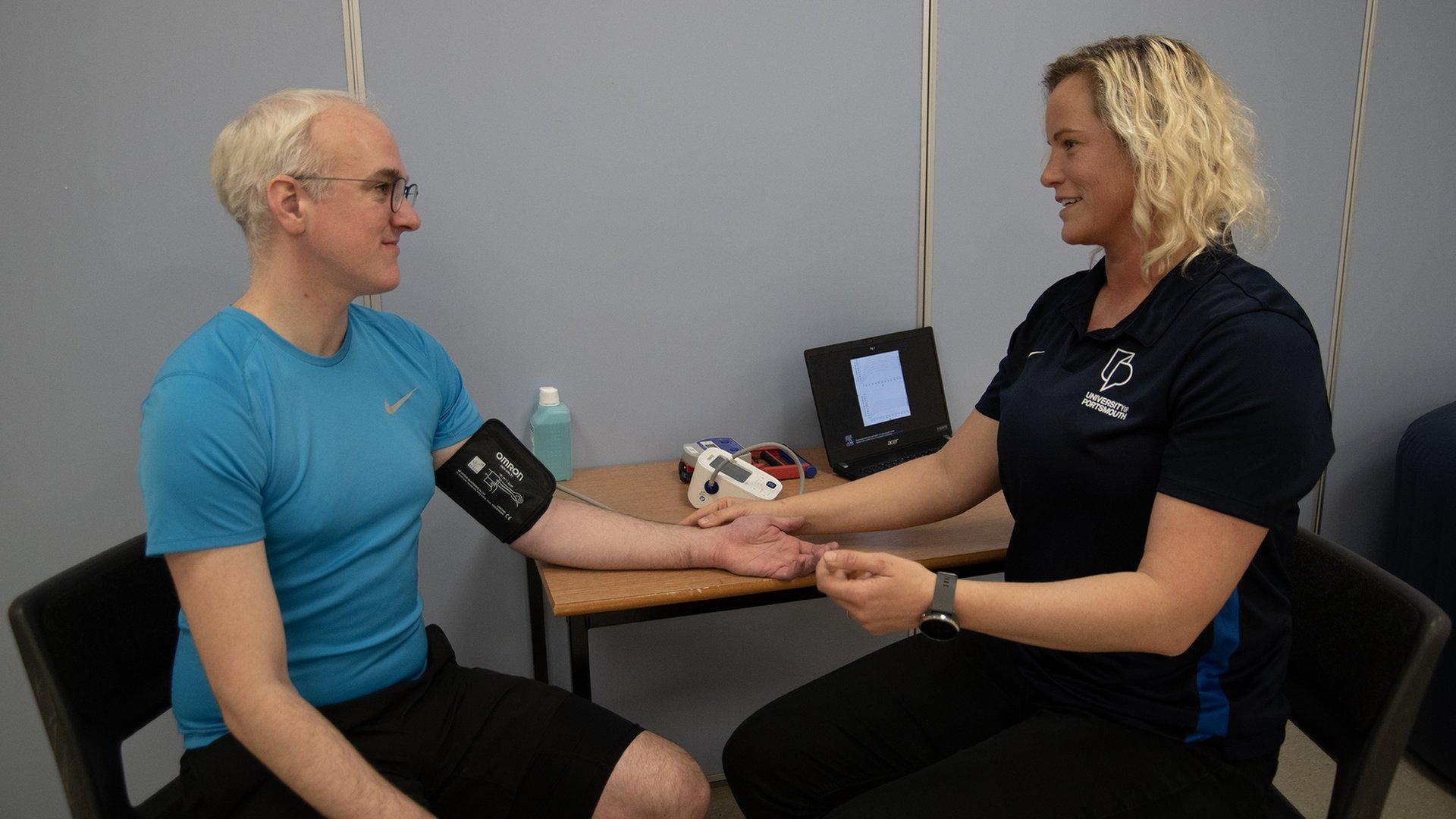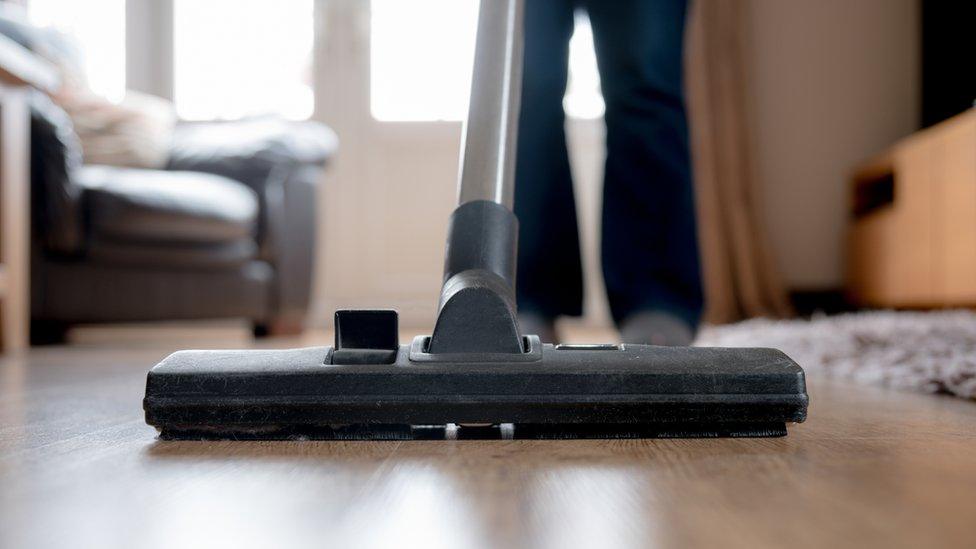What's the least exercise we can get away with?
- Published

How much exercise do you manage to do?
In a parallel universe I practically live in the swimming pool, cycle everywhere and knock out 10km (six miles) runs just for fun.
However, in the real world of work, family and being a carer, my weekly swim feels like an achievement.
We are recommended to do nearly two and a half hours (150 minutes), external of moderate-intensity exercise each week. About a quarter of the population do not even manage half an hour, external.
So is there something easier we can aim for? What is the least amount of exercise that will start to improve our health?
Someone who is keen to make exercise advice less intimidating is Dr Zoe Saynor, assistant professor of clinical exercise physiology at Portsmouth University, not to mention a retired elite-level rugby player.
She is going to help me look for an answer. To this end, I've been wearing an activity tracker for a week.

Dr Zoe Saynor invited me to her laboratory at the University of Portsmouth
I'm going to get my excuses in early - it was an incredibly busy week at work, and I was tied to my desk most of the time I was wearing it.
The results are still horrifying. I managed only one minute of vigorous exercise (equivalent to running) every day, and 16 minutes of moderate exercise (something like a brisk walk).
"That's a picture that we see time and time again in lots of people living in modern society," says Dr Saynor.
Whatever state my body is in, a lot is going to depend on that single hour of swimming I squeeze in most weekends.
Listen to Inside Health podcast: The lazy guide to exercise
Go fast, or go far?
If you want to spend less time exercising - but still achieve high results - then the only option is to work harder.
"There's clear evidence that if you want to do shorter exercise sessions, they need to be of a higher intensity," says Dr Saynor.
In official guidance, the alternative to doing 150 minutes of moderate activity is to do 75 minutes vigorously.
High-intensity interval training (HIIT), involving short but very explosive bouts of activity, gets a lot of attention.
However, Dr Saynor says most people cannot stick to it because HIIT requires exercising at such intense levels.
What is the bare minimum?
When it comes down to the least amount of exercise people should do, Dr Saynor says she is a firm believer in 5,000 to 6,000 steps a day.
It is easy to scoff at advice to get off the bus one stop early, or go for a stroll on your lunch break but it does seem to make a difference.
A study of nearly 80,000 people published in JAMA Internal Medicine, external showed that walking a bit more every day reduced the risk of cancer, cardiovascular disease or an early death.
That pattern continues until you reach about 10,000 steps a day - again, faster steps are worth more than slow ones.
"If you have no time to suddenly do 10,000 steps a day, can we get you to do 5,000 steps faster? We will see an improvement in your health," Dr Saynor says.
You do not even have to do formal exercise like going for a run, hitting the gym or swimming to see a noticeable health benefit.
A study, published in Nature Medicine, external, looked at 25,000 people who do not "exercise" as such but perform small vigorous bouts of activity in day-to-day life.
This could be really unextraordinary stuff - running for a train, pushing the vacuum cleaner around, playing with the kids or the dogs, carrying in the heavy shopping or taking the stairs.
The research showed between three and four minutes of short vigorous activity in bursts over the day had a profound health benefit.
"The people that are displaying this intermittent activity can reduce their risk of major diseases, such as heart disease and cancer, by up to 50%," Mark Hamer, professor of sport and exercise medicine at University College London, tells me.
"Over the last decade, the guidelines have been slowly edging away from the message of 30 minutes a day more towards the message of 'anything counts', and I think these results back up that message."

Lie back in the bath - and get fit?
If you still do not have time to do it, there may be another way - and it sounds much more enjoyable.
How does a bath, hot tub or sauna sound?
I have changed into my favourite swim shorts - a fetching pink-flamingo pair - and I am being lowered into a very warm bath.

This is a precisely controlled experiment so I cannot just hop in. Researcher Thomas James has to winch me into a pool of water at 40C so only my head and neck are above water.
The point of 40C is that it is higher than my core body temperature (37C), so all the time I am in here my body is working hard to lose heat.
Very quickly I can feel the sweat beading on my forehead but on the rest of my body it is just being washed away and is not cooling me down.
"Hot water is actually particularly lethal in this respect," says Mr James.
If I spent too long in here I would overheat and die of heatstroke. My heart pumps harder and more quickly as it tries to lose heat by getting blood closer to the surface of my skin.
"Your heart will be working hard, similar to what you would see with light intensity exercise," he says.
"We're seeing reductions in blood pressure, even in healthy people."
The big idea is to enhance exercise.
"This is a really good way of mimicking some of those benefits you get from exercise but the evidence is certainly pretty clear that exercise is best and then the two together get the biggest health benefits," says Mr James, adding: "I think this will really play a big part in the future."
So if you go to the gym and then hit the sauna or a hot tub afterwards you might get a cheeky boost.
However, the team at Portsmouth caution people to stick to the recommendations.
"Don't go, 'I'm going to stay in here as long as I can.' Do it for enjoyment," says Mr James.
The advice is often between 10 and 20 minutes depending on exactly what facilities you are using, so do check.
Obviously all of us should be aiming to do the recommended amount of exercise but, given that many of us find that impossible, it is hugely reassuring that there are significant benefits to be had just by doing a little bit more than we are already.
Inside Health was produced by Erika Wright.

More from Inside Health
Multiple sclerosis: Is a virus we all have causing MS?
Long Covid: 'I've had long Covid for two years now'